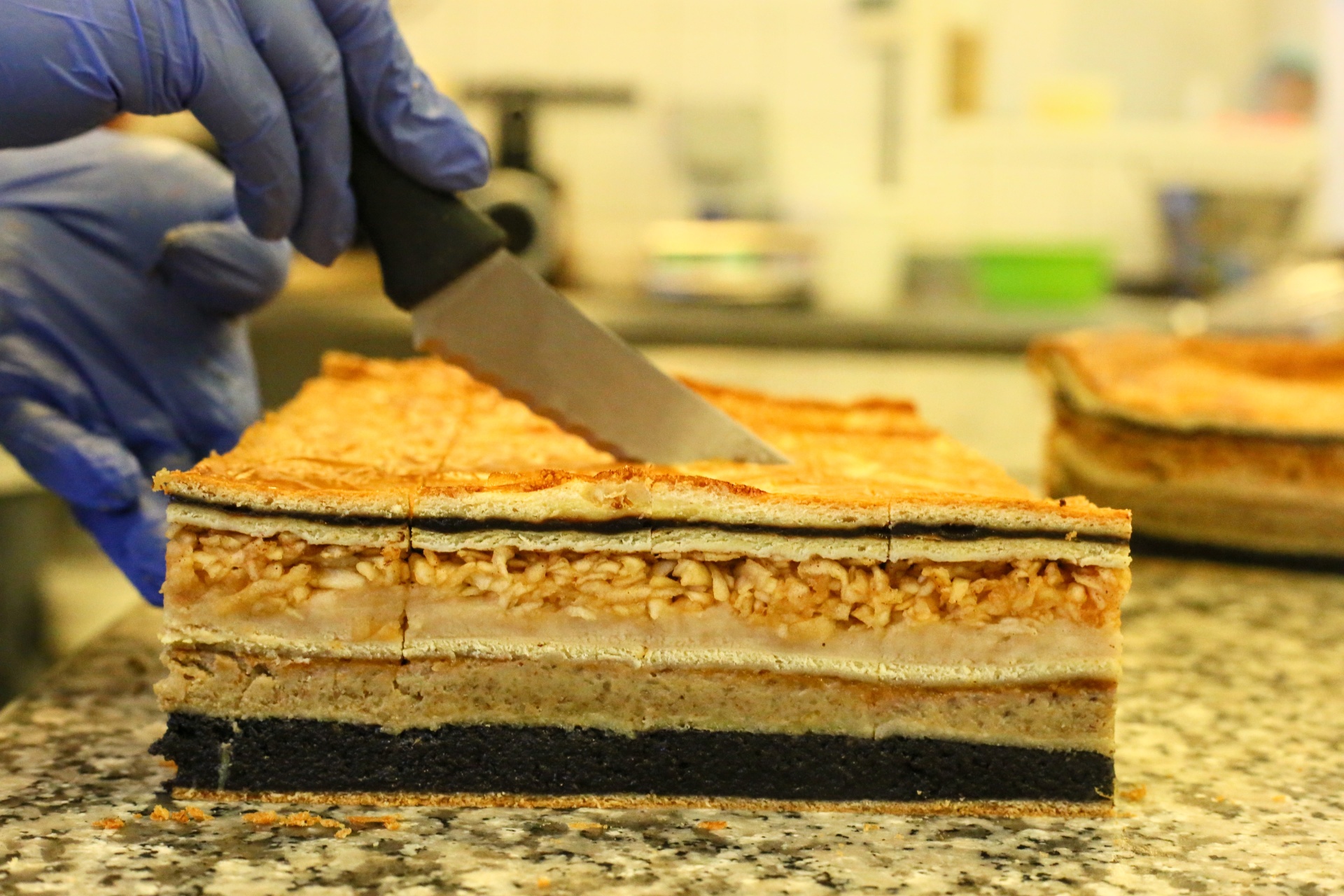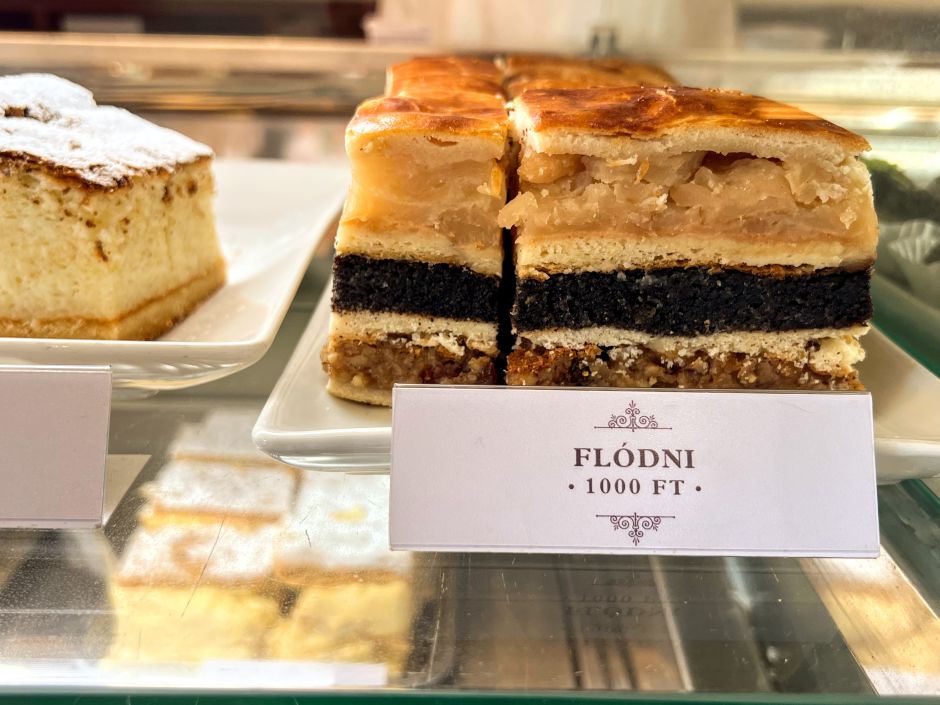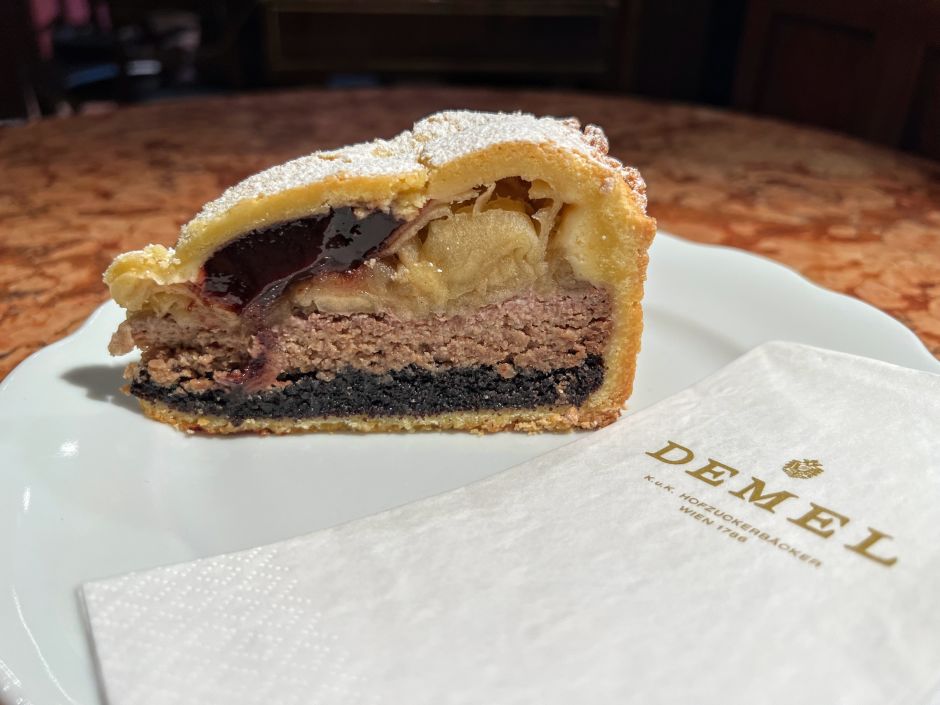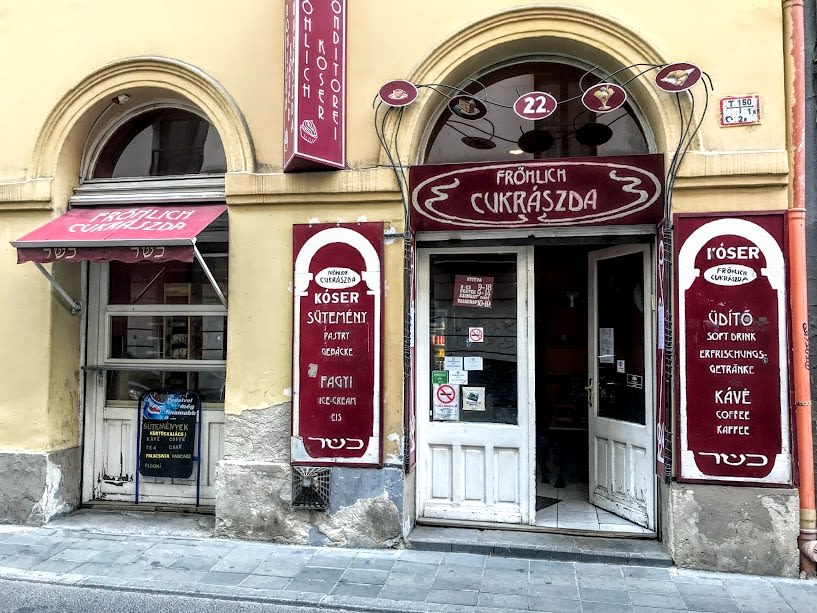Traditionally made by Hungarian Jews for a religious festival, the flódni has since spread deep into the Budapest mainstream.

With an estimated 80,000 to 120,000 people, Budapest is home to the biggest Ashkenazi Jewish community in continental Europe. Most people today are assimilated and non-practicing, so few obvious signs of Jewish culture exist apart from three impressive and largely empty synagogues in the city center. But look behind the surface, and Jewish contributions to present-day Budapest start to reveal themselves: from the Yiddish-inflected Hungarian language the city speaks, to the countless Art Nouveau buildings Jewish-Hungarian architects designed.
Culinary influences go both ways. Hungarian Jews often mirrored Christian households in the 19th century, adjusting dishes to their own dietary laws (kashrut). This meant they omitted sour cream from the chicken paprikash, for instance, since meat and dairy can’t mix. As assimilation progressed, fewer and fewer people kept kosher and today almost no one does. (The handful of kosher restaurants in Budapest’s Jewish Quarter currently cater to orthodox and Hasidic tourists.)
At the same time, typical Jewish dishes spread into the mainstream. Many non-Jewish Hungarians today admire a hearty cholent, the Shabbat lunch of stewed beans, and matzo ball soup doesn’t seem out of place on a restaurant menu. But the one Jewish food that eclipsed all others is a pastry, perhaps not surprising for a country like Hungary that loves its sweets and decadently stacked tortes of all shapes and sizes.
Flódni is a rich layered cake Hungarian Jews traditionally made for Purim, the joyous festival celebrating the Queen of Persia who prevented the mass killing of Persian Jews in the 5th century B.C. In the seminal book on Hungarian Jewish Cuisine, author András Koerner writes that the flódni’s origins go back to the medieval German filled pastry, the fladen, and that after centuries of dormancy, it re-appeared in its current form among Hungarian Jews in the late 19th century.
Rich in fillings and elaborate in preparation, flódni is a special-occasion cake. Consider its three main layers: ground walnuts sweetened with sugar; ground poppy seeds brightened with lemon zest; grated apples spiked with cinnamon and anointed with honey. Many versions call for an additional layer of homemade plum jam. All this framed by a crumbly shortcrust pastry.

By the 1930s, flódni was widely popular among Hungarian Jews. People made it not just for Purim but also birthday parties and weddings, and Jewish restaurants served it year-round. It’s telling that an anti-semitic newspaper in the 1940s, Magyarság, taunted the Jews for their tendency to gorge themselves on flódni.
In neighboring Vienna, a cake very similar to the flódni, Fächertorte, was popular among Austrian Jews before 1945. However, there’s no Fächertorte renaissance in Vienna today; in fact, only one pastry shop still serves it (Demel). The disappearance of the Fächertorte parallels the disappearance of Vienna’s Jewish community, which once counted 200,000 members and was the third biggest in Europe after that of Warsaw and Budapest.

That Budapest’s Jews didn’t suffer a fate similar to those in Vienna, or to those nearly half a million people in the Hungarian countryside who were deported and murdered in Auschwitz, is for reasons of good fortune. Despite Nazi-organized raids and death marches, the Soviet army liberated Budapest and its Jewish ghetto in January 1945, before mass deportations could begin. This meant Budapest retained a meaningful Jewish community even as thousands immigrated to Israel in the post-war years and during the revolution of 1956.
It was in the 1950s that the flódni spread beyond Jewish homes and confectioneries, and the place that popularized it most was Frőhlich. Opened in 1953 by György Frőhlich and a partner who later fled Hungary, it was one of the few privately owned pastry shops in Communist-era Budapest (1947-1989) and one with a stellar reputation.

“By the 1960s, Frőhlich was well-known among both Jews and non-Jews alike. And since the flódni was a signature product, more and more people got to know it,” said Éva Zádor, niece of György Frőhlich, who died in 2010. It also helped that the Jewish Quarter – the inner part of Budapest’s District 7 – where Frőhlich was located, had a meaningful non-Jewish population by then. (Sadly, Frőhlich is no longer: it closed its doors during the pandemic).
Soon, flódni was available at Budapest’s top pastry shops. “When I started out in 1971, we already made it,” said József Auguszt, scion of the legendary Auguszt pastry shop, who still mans the counter every day at their flagship location in Fény utca (and who spent a year-long internship at Frőhlich as a young man). Even Café Gerbeaud, Hungary’s most famous and fanciest, had flódni on its menu.
Since the early 2000s, the flódni moved even deeper into the Budapest mainstream thanks to a couple of young Jewish Hungarian pastry makers who revived old family recipes and spread the word through TV shows, food festivals, and cookbooks. The pioneer of the new-wave flódni was Ráhel Raj, but she has since moved on and currently Judit Vámos is considered by many the Queen of flódni.
Quick detour: flódni – fluden in Yiddish – has largely disappeared from the Hungarian Jewish ultra-orthodox community of Brooklyn, even though they retained many dishes of the “motherland.” On the other hand, kindli (kindle in Yiddish), another Jewish-Hungarian cake, is still popular there, especially for Purim and the Simchat Torah festival, but has totally vanished from Hungary.
Back in Budapest, at a warehouse in District 11, Judit and her small team make hundreds of flódni each morning that land at the city’s leading restaurants, cafes, and pastry shops by midday. She has long tinkered with her mother’s flódni recipe which she now carefully guards, not even her employees know the specifics (Judit herself prepares the fillings the night before the baking).
“Walnut and poppy seed fillings are familiar to Hungarians,” she says when I ask about her flódni’s popularity. It also helps that bejgli, a traditional Christmas pastry, is somewhat similar. In fact, peak flódni season in Hungary is Christmas, which is of course ironic for a traditional Jewish pastry. “We sell twenty times more in a day than normally. People who have tired of the bejgli like to spruce things up with our flódni.”
Perhaps the next chapter of the flódni story will be written outside of Hungary, as Judit has been approached by companies in Austria, Poland, and the United Kingdom that want to import her flódnis. I’m very happy for her, I said, as long as she can ensure that the supply of the Budapest market remains uninterrupted.
Below, you’ll find a flódni recipe I created from several different sources, some old, some more recent.

Recipe:
Yield: makes about 30 flódni; Total time: 3 hours (2 hours prep time, 1 hour baking time)
For the dough
500 grams (1 pound; 4 cups) all-purpose flour
3 medium eggs
100 grams (½ cup) sugar
250 grams (1 cup) butter, diced
⅓ cup water
Pinch of salt
For the apple filling
1.2 kilos (2 ½ pounds) apples, peeled, cored, and grated (comes out to about 800 grams or 1 ¾ pounds net)
Lemon juice, using 1 medium lemon
3 tablespoons honey
1 tablespoon ground cinnamon
For the walnut filling
300 grams shelled walnuts, ground (3 ½ cups)
100 grams (½ cup) sugar
1 tablespoon freshly grated orange zest (using 1 medium orange)
½ cup water
For the poppy seeds filling
300 grams (2 cups) ground poppy seeds
100 grams (½ cup) sugar
1 tablespoon freshly grated lemon zest (using 1 medium lemon)
½ cup water
For the plum jam filling
1 jar (350 gram / 12-ounce) plum jam, ideally homemade (sorry!)
For the egg wash
1 large egg
1 tablespoon milk
Directions
Step 1: Combine ingredients for the rich shortcrust dough – flour, butter, sugar, salt, eggs, water – using your hands or a food processor until it forms a ball. Divide the dough into five equal parts, flatten each to a disc, and let it rest in the refrigerator while you prepare the fillings (at least 1 hour).
Step 2: Prepare the walnut filling. Add water and sugar to a saucepan on low heat and mix until sugar dissolves. Turn off heat, add ground walnuts and orange zest and mix well. You should get a solid, but easily spreadable texture.
Step 3: Prepare the poppy seed filling. Add water and sugar to a saucepan on low heat and mix until sugar dissolves. Turn off heat, add ground poppy seeds and lemon zest and mix well. As with the walnuts, you should get a solid, but easily spreadable texture.
Step 4: Prepare the apple filling. In a bowl or saucepan, combine lemon juice, grated apples, honey, and cinnamon and mix well.
Step 5: Take your dough from the refrigerator. Using a rolling pin and a well-floured board, roll into a size that covers the surface of your baking pan. I used a 34 cm x 26.5 cm (13.4 x 10.4 inches) baking pan.
Step 6: Place the first layer of dough in the baking pan, then add the poppy seed filling and spread evenly. Another dough comes next, then the walnut filling. Same with the apples and the plum jam. Separate each filling by a layer of dough. The order of fillings doesn’t matter.
Step 7: Make the egg wash: combine whisked egg and milk in a small bowl. Then, using a brush or a spoon, coat the top of the flódni (this will yield a shiny, golden crust).
Step 8: Preheat oven to 175 degrees Celsius (350 Fahrenheit) and bake the flódni for one hour. When ready, let it cool a bit and cut into 5 cm by 5 cm cubes (2 by 2 inches) and serve either hot or cold. Even better with chilled Tokaji sweet wine on the side.